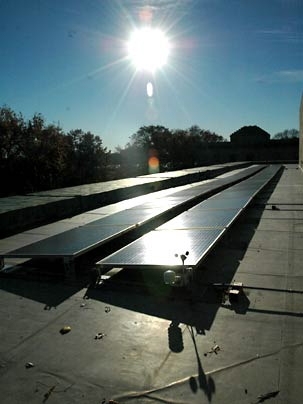MIT is one of 20 university teams selected to compete in the 2007 Solar Decathlon, sponsored primarily by the U.S. Department of Energy. The team will receive $100,000 in seed funds over the course of two years to design and develop an energy-efficient house that provides all the domestic needs for a small urban family -- including sufficient energy to power an electric car -- using only the power of the sun. Further financial support for construction and transportation is being sought from industrial sponsors.
Headed by Andrew Scott, associate professor of architecture, the exploratory workshop this spring involved about a dozen students from architecture, building technology, electrical and mechanical engineering and materials science.
First conducted in 2002, and again in 2005, the Solar Decathlon is an international competition challenging college teams from around the globe to blend aesthetics and modern conveniences with maximum energy production and optimal efficiency. In the fall of 2007, students from U.S. universities -- as well as from schools in Canada, Germany and Spain -- will transport their solar houses to the competition site on the National Mall in Washington, D.C., and rebuild them there in a solar village. The houses, and the sponsors' exhibits, will be open to the public.
The purpose of the competition is to challenge students to think in new ways about energy, to increase public awareness about renewable energy and energy efficiency and to help move solar energy technologies to the marketplace faster.
MIT's participation in the contest continues a long-standing legacy of research at the Institute into solar powered houses, beginning in 1938 when Godfrey Lowell Cabot gave MIT a gift to be used for the development of "the art of converting the energy of the sun to the use of man." The endowment enabled the creation of MIT's Solar Energy Research Project, a 50-year effort involving the design and construction of six experimental or prototypical solar houses.
Solar I, completed in 1939, was the first house in America to be heated by the sun's energy. A single-story house-like structure on the MIT campus, Solar I used solar radiation as a heat source for the winter, but projects were also conducted on summer air conditioning and power generation.
A series of solar houses followed. Solar V was erected in 1978 on the MIT campus and used as an experimental studio/classroom by the Department of Architecture. Unlike the first four solar houses, Solar V did not require mechanical equipment such as solar collectors, pumps or fans: All elements of solar heating were incorporated into the building materials.
The sixth solar house, the Dover Sun House, was different from the others. Sponsored by Boston heiress and sculptress Amelia Peabody, the house heating unit was designed by Maria Telkes, a researcher in MIT's Department of Metallurgy, and instead of water, the heat storage material was Glauber salts (sodium sulfate decahydrate). Architect Eleanor Raymond drew up the plans for the five-room house and a cousin of Telkes' lived in the house with his wife and child for three years, at which point the system failed.
The Solar Decathlon is sponsored by the Office of Energy Efficiency and Renewable Energy at the U.S. Department of Energy, in partnership with its National Renewable Energy Laboratory, the American Institute of Architects, the National Association of Home Builders, BP, the DIY Network and Sprint.
A version of this article appeared in MIT Tech Talk on May 3, 2006 (download PDF).






